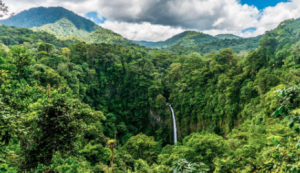Discover how Namib Desert wildlife thrives in extreme conditions – elephants, beetles, plants & more adapt uniquely to survive harsh environments.
GVI
Posted: July 9, 2024

Zaytoen Domingo
Posted: December 5, 2020
Costa Rica is leading the charge worldwide when it comes to being green and sustainable. Supporting countries that strive for environmental excellence has never been more important! So here are 3 reasons why Costa Rica is doing so well and why they deserve your tourism!
Costa Rica has repeatedly run the entire country on renewable power for long periods of time. Back in 2018 they spent over 100 days running purely on renewable energy. Costa Rica is lucky to have an abundance of free flowing water which can be used in hydroelectric dams to generate over 78% of its electricity needs. 
Head up into the hills and mountains and you’ll also find an abundance of wind farms spinning for power. With many mountains and high elevations, Costa Rica makes the most of it and places these wind farms in areas of high winds to collect as much energy as possible.
Costa Rica had aimed to be running solely from renewable energy by the end of 2020. Whether that will happen still remains to be seen, but if they don’t meet their goal this year, they are well on track to achieving this goal in the near future.
2. Forest regeneration:
Back in the 60s, Costa Rica had hit the peak of it’s logging boom which lead to the country only retaining 15% of its entire forest cover. Originally being covered from coast to coast in rainforest and tropical dry forest alike, the government decided to make a drastic decision to change this.
 They started a buy back scheme, urging farmers to sell their land back to the government so that it could be regenerated into forest and turned into protected areas and national parks. Farmers were also given benefits for regenerating portions of their land and for practicing sustainable farming strategies. This means that Costa Rica today has managed to regenerate their forests back to cover just over 51% of the country.
They started a buy back scheme, urging farmers to sell their land back to the government so that it could be regenerated into forest and turned into protected areas and national parks. Farmers were also given benefits for regenerating portions of their land and for practicing sustainable farming strategies. This means that Costa Rica today has managed to regenerate their forests back to cover just over 51% of the country.
Tortuguero National Park is one of these protected areas, and back before it was a national park it was in fact primarily farm land. By walking through it you wouldn’t know it! Which just goes to show how quickly an environment can bounce back if it is given the help and time it needs.
3. Certification of sustainable tourism and Blue Flag program:
With the energy industry and local farmers on board with sustainable practices, the next challenge Costa Rica faced was trying to encourage local businesses to follow the same example. They did this through their sustainable tourism certification program which encourages tourism companies to adapt a long-term perspective to their practices so that Costa Rica’s resources and culture can be protected. With a 1 to 5 grading system, it also allows tourists to make smart choices in the companies they choose to do business with. Higher ratings guarantee that the company supports the local communities and does not damage the local environment when they carry out their practices and make business decisions.

The Blue Flag program is another venture that the Costa Rican government has taken in its venture for environmental excellence. Blue flags are awarded to beaches and their community that have high quality water, drinking water, excellent waste disposal systems, sanitary facilities, signage, tourist safety, environmental education and involvement of the community in beach maintenance. Once awarded, these beaches achieve monthly audits to make sure these practices are still up to scratch.
Costa Rica is the world leader in sustainability and environmental practices and it’s not hard to see why. With such innovation across the country, it’s amazing to see so many communities involved and striving for excellence. It’s definitely a country worth investing in and hopefully it’s not long before the rest of the world follows in their footsteps.
By Zaytoen Domingo
Discover how Namib Desert wildlife thrives in extreme conditions – elephants, beetles, plants & more adapt uniquely to survive harsh environments.
GVI
Posted: July 9, 2024